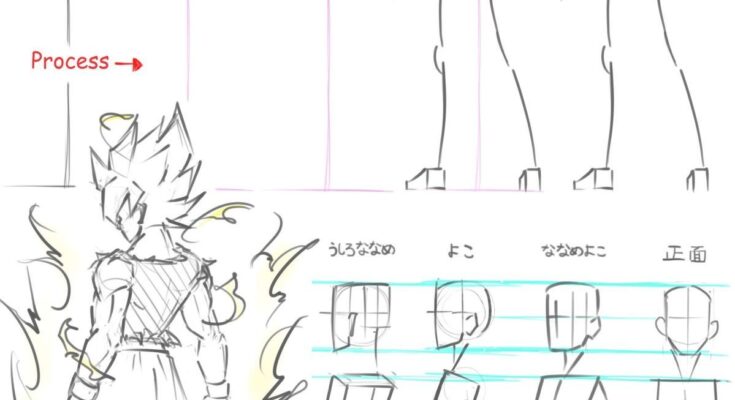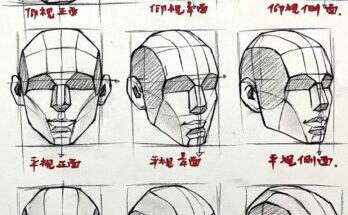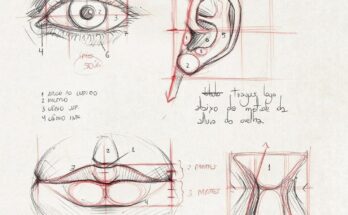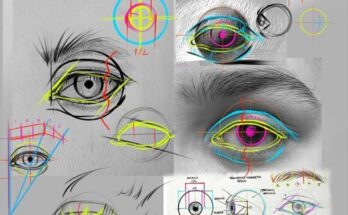Step-by-Step Tutorial on Drawing a Futuristic Hover Car: Design, Details, and Urban Atmosphere for Sci-Fi Illustration

Designing a futuristic hover car is an exciting challenge for artists exploring sci-fi art, concept design, or futuristic cityscapes, blending sleek aesthetics with advanced technology for a visionary illustration. This comprehensive tutorial is inspired by a reference sketch titled “Hover Car,” which depicts a streamlined, levitating vehicle with a curved chassis, glowing propulsion engines, and angular windows, rendered in pencil with precise detailing and light shading. The image features red construction lines to guide perspective, structural proportions, and engine placement, while annotations highlight key elements such as aerodynamic contours, neon accents, and a bustling urban skyline in the background. The composition captures a high-tech, dynamic atmosphere, making it an ideal foundation for sci-fi posters, game assets, or cinematic concepts.
This guide is tailored for intermediate artists, whether working traditionally with graphite on smooth paper or digitally using tools like Procreate, Photoshop, or Blender, where layers can manage base sketches, metallic textures, and effects. We’ll break it down into sections based on the reference: establishing perspective and base structure, detailing the chassis and engines, refining windows and accents, and adding urban context. Key techniques include mastering two-point perspective for depth, layering reflective surfaces for a metallic sheen, and using value gradients to convey a futuristic glow. This approach suits sci-fi narratives, vehicle design portfolios, or animated sequences, encouraging reference from modern car designs (e.g., concept EVs) or sci-fi films (e.g., Blade Runner). Start with light sketching tools (e.g., H pencil or 20% opacity brush), a ruler for straight lines, and an eraser for adjustments, progressing to B pencils or opacity builds for shading. Given today’s date—10:18 AM EDT on Sunday, October 26, 2025—this tutorial aligns with a bright morning light setting, enhancing the car’s sleek highlights.
Section 1: Establishing Perspective and Base Structure (Red Construction Lines)
The reference’s red lines provide a structural framework, capturing the hover car’s sleek form and balanced composition.
- Setting the Horizon Line and Vanishing Points: Draw a horizontal line across your canvas to represent the viewer’s eye level, placed midway (e.g., half the canvas height) to suggest a ground-level view. Choose a two-point perspective with vanishing points off-canvas to the left and right, converging lines toward the car’s front and rear. The reference’s low-angle perspective enhances the vehicle’s dominance, so tilt the horizon slightly upward. Mark the vanishing points with light dots.
- Blocking in the Base Structure: Sketch the chassis as an elongated, curved prism, tapering toward the rear, with a low profile for aerodynamics. Add the propulsion engines as cylindrical pods beneath, aligned with the undercarriage. The cabin is a streamlined dome with angular windows. Proportions: The chassis should span 60-70% of the width, with engines 20-25% of the height. Use light lines to outline the hover effect as faint ovals beneath.
- Practical Tips: Use a ruler for precision in perspective lines. Common error: Uneven tapering—measure lengths to maintain symmetry. Tip: Study concept car sketches or aerodynamic designs for inspiration. Exercise: Draw a simple curved chassis with engines, applying two-point perspective, then adjust for a slight tilt to match the reference’s dynamic angle.
This foundation ensures structural integrity, preventing distorted or flat appearances.
Section 2: Detailing the Chassis and Engines (Metallic Texture)
The reference’s pencil work focuses on texture and detail, bringing the hover car’s futuristic design to life.
- Chassis Contours: Refine the chassis with smooth, flowing lines to suggest aerodynamic shaping, adding subtle panel lines for a modular look. The image shows a curved surface, so use light shading to imply a metallic sheen, with reflections along the edges.
- Propulsion Engines: Detail the engines with segmented rings and glowing cores, drawn as small circles or ovals with radiating lines for energy. The reference’s annotations suggest neon accents, so plan light from above-left with bright highlights. Add exhaust vents with grid patterns for texture.
- Hover Effect: Sketch faint, wavy lines or ovals beneath the car to indicate levitation, tapering as they recede. The image’s shading suggests a slight distortion, so blend softly with a stump or airbrush.
- Application Notes: Vary line weight—thicker for the chassis, thinner for engines. Avoid mistake: Flat surfaces—add curves for depth. Exercise: Detail an engine pod with glow and vents, then replicate on the chassis.
These elements build the car’s high-tech aesthetic, grounding it in futuristic realism.
Section 3: Refining Windows and Accents (Cabin Details)
The reference’s cabin details draw attention, with windows and accents enhancing the vehicle’s personality.
- Window Construction: Sketch the windows as angular trapezoids or polygons, converging toward the vanishing points. The image shows tinted glass, so use light shading with a gradient from dark edges to a bright center, suggesting reflections.
- Neon Accents: Add glowing strips or dots along the chassis edges and engine pods, drawn as thin lines or small circles with a soft halo. The reference’s annotations suggest blue or green hues, so plan complementary highlights.
- Integration Tips: Align windows with the cabin’s curve, ensuring accents follow the aerodynamic flow. Common pitfall: Overloading details—limit neon to 5-7 elements. Exercise: Draw the cabin with windows and accents, varying tint shades.
These elements bring the car’s interior and style to life.
Section 4: Adding Urban Context and Final Touches
The reference’s skyline background and shading create a morning urban scene, enhanced by 10:18 AM EDT lighting.
- Environmental Context: Sketch a cityscape with tall, angular buildings, a road beneath, and a faint sky with cloud wisps. The image suggests a futuristic setting, so add hovering traffic or holographic signs. With 10:18 AM EDT lighting, use a warm yellow-orange wash for sunlight, casting shadows rightward.
- Shading and Highlights: Apply gradients on a Multiply layer—darkest under the chassis, engine bases, and window edges; brightest on the roof, engine cores, and neon strips. Use the above-left light source implied in the image, adding specular highlights (small white dots) on metallic surfaces for a glossy effect.
- Final Details: Add a driver silhouette, faint exhaust glow, or distant aircraft. The reference’s light shading hints at haze, so soften distant edges with a gray overlay (10-15% opacity).
- Critique and Adjustment: Erase guidelines, sign in a subtle corner (e.g., lower-right), and flip horizontally to check symmetry. Adjust shading if the car blends into the background.
Additional Professional Tips for Mastery
- Tools and Materials: 2H for outlines, 4B for shading; digitally, use custom metallic brushes. Reference concept car designs or sci-fi cityscapes.
- Common Challenges: Perspective errors—use a horizon guide. For lighting, study morning urban photos (e.g., 10-11 AM).
- Exercises and Resources: Weekly: 30-minute hover vehicle sketches from different angles. Explore “The Art of Sci-Fi Concept Design” by Iain McCaig or online vehicle design tutorials.
- Extensions: Add a chase scene, vary colors (e.g., silver, red), or depict a night version with enhanced neon.
This tutorial transforms the reference into a practical roadmap, enabling you to craft a futuristic hover car with confidence. Practice consistently, and explore variations like spaceports or racing scenes in our related guides!



